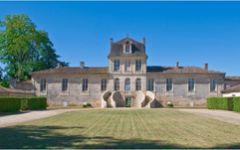Chateau de Myrat Sauternes (375ML half-bottle) 2016
-
James
Suckling -
Wine
Spectator -
Robert
Parker - Decanter



Product Details
Your Rating
Somm Note
Winemaker Notes
Due to its particular terroir of Barsac, the wines from château de Myrat are very fine, elegant and rich, with pepper and spices aromas and a fresh minerality.
Professional Ratings
-
James Suckling
This shows serious intensity and richness with a medium to full body, lots of sweetness and a rich finish. Oily. Better than the 2015.
Barrel Sample: 93-94 -
Wine Spectator
Alluring ginger cream, glazed peach and honey notes glide through, with nice weight and length on the piecrust-infused finish.
Barrel Sample: 91-94 -
Robert Parker's Wine Advocate
The 2016 Myrat has a very perfumed bouquet with touches of petrol at first, although that recedes and leaves some lovely citrus/honeyed fruit. The palate is well balanced with a crisp line of acidity. There is plenty of vibrant, energetic fruit here and great precision on the finish. Dry Myrat has been on a roll recently and this continues their purple patch of excellent Sauternes.
Barrel Sample: 92-94 Points -
Decanter
I like the pointed citrus on the nose, which is followed by a lovely rich texture and fairly striking citrus flavours. This errs on the luxurious side, and it has great persistency and wonderful depth, but could do with pepping up just a little bit.
Barrel Sample
Other Vintages
2007-
Wine
Spectator -
Robert
Parker
-
Wine
Spectator


The name was Chateau Mirat which was later revised to Chateau de Mirat. During the 1855 classification the castle was owned by the family Molle, which at that time got Chateau de Mirat classified in Les seconds Crus.
When Chateau de Myrat got the current spelling is unclear but it must have been after the classification 1855. Despite the extensive restoration of the vineyard, which was completed 1945, Max de Pontac was not pleased with the results, and 1976 he took the courageous decision to pull all the vines at Chateau de Myra. This was a shocking decision that has never before been implemented among the classified castles in Sauternes.
The sons Jacques and Xavier became clear with the new plantings 1988, and today Chateau de Myrat withdrawn its role among the classified castles in Sauternes.

Apart from the classics, we find many regional gems of different styles.
Late harvest wines are probably the easiest to understand. Grapes are picked so late that the sugars build up and residual sugar remains after the fermentation process. Ice wine, a style founded in Germany and there referred to as eiswein, is an extreme late harvest wine, produced from grapes frozen on the vine, and pressed while still frozen, resulting in a higher concentration of sugar. It is becoming a specialty of Canada as well, where it takes on the English name of ice wine.
Vin Santo, literally “holy wine,” is a Tuscan sweet wine made from drying the local white grapes Trebbiano Toscano and Malvasia in the winery and not pressing until somewhere between November and March.
Rutherglen is an historic wine region in northeast Victoria, Australia, famous for its fortified Topaque and Muscat with complex tawny characteristics.

Sweet and unctuous but delightfully charming, the finest Sauternes typically express flavors of exotic dried tropical fruit, candied apricot, dried citrus peel, honey or ginger and a zesty beam of acidity.
Sémillon, Sauvignon Blanc, Sauvignon Gris and Muscadelle are the grapes of Sauternes. But Sémillon's susceptibility to the requisite noble rot makes it the main variety and contributor to what makes Sauternes so unique. As a result, most Sauternes estates are planted to about 80% Sémillon. Sauvignon is prized for its balancing acidity and Muscadelle adds aromatic complexity to the blend with Sémillon.
Botrytis cinerea or “noble rot” is a fungus that grows on grapes only in specific conditions and its onset is crucial to the development of the most stunning of sweet wines.
In the fall, evening mists develop along the Garonne River, and settle into the small Sauternes district, creeping into the vineyards and sitting low until late morning. The next day, the sun has a chance to burn the moisture away, drying the grapes and concentrating their sugars and phenolic qualities. What distinguishes a fine Sauternes from a normal one is the producer’s willingness to wait and tend to the delicate botrytis-infected grapes through the end of the season.
